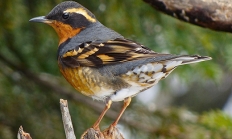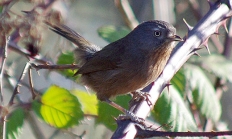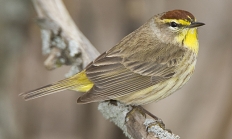Search myodfw.com
The bold eye-ring, white outer rectrices, and intricate buff wing pattern distinguish this elegant gray thrush at close range. The scaly patterned brown juveniles are quite unique in appearance. The complex song is varied, soft and flute-like at times, strong and powerful at others. The call carries well, and is a characteristic sound of the winter bird community in juniper woodlands east of the Cascades. It is a summer resident in the Coast Range. It breeds in and near open coniferous forest stands, natural forest openings, burned areas, shelterwood cuts and clearcuts to the timberline. Hear the song of the

The Veery is known less for its appearance than for its ethereal song, a series of spiraling, reverberating flutelike notes, each lower in pitch, suggesting the name: vee-ur, vee-ur, vee-ur. A patient observer may get a fleeting glimpse of a small thrush with reddish brown upperparts, pale undersides, and a buffy upper breast with a few darker spots. It is an uncommon breeder in lower to middle elevations in the Blue Mountains where sufficient riparian thickets exist for cover and forage needs. It is locally common along watercourses in Union, Wallowa, and east Umatilla counties, and less common in north

Although they are one of the most abundant breeding birds in forests and woodlands west of the Cascade crest, it can be difficult to actually see Swainson's thrushes. Drab plumage and the habit of sitting very still hides them from the eyes of would-be predators and birdwatchers alike, especially in the shrubby habitats they favor. However, the beautiful song of this minstrel compensates for a lack of colorful plumage. During the longest days of summer, a chorus of liquid notes rising from the deep shadows each dawn and late afternoon reveals the actual abundance of this species in the conifer

Rather plain gray to brown with a spotted breast and reddish tail, the unobtrusive Hermit thrush blends well with the dappled light of the forest understory. It is famous for its sweet, clear, musical song. In includes three or four passages, separated by considerable intervals at higher or lower pitch, but each opens with a flute-like note that gives the performance the effect of a chant of sacred music. In Oregon, during migration and in winter, Hermit thrushes may be found in some residential areas that have dense stands of shrubs, particularly berry producers, and conifers. Hear the song of

When glimpsed in the deep shadows of its preferred densely forested habitat, this secretive thrush resembles a plump robin. But a clearer view will reveal the distinctive fieldmarks of a dark breast band, orange eyebrows, and orange wingbars. As striking as its plumage is its unmistakable song: a succession of single drawn-out, ventiloquial notes, given at different pitches that pierce the fog and dense foliage of its favored haunts in lush coastal and montane old-growth forests. In Oregon, it breeds throughout the Coast Ranges and in the Cascades. It is a fairly common breeder in low-elevation hemlock and spruce forests

This is a mouse-like bird, only occasionally musters the courage to dart from its shadowy domain. The male and female are generally indistinguishable by external characters. Both sexes are small and brown, with dim streaks on a paler, often pinkish breast; generally paler and grayer in drier regions. Both sexes sing; the female's repeated single note is easily distinguishable from the male's fast trill introduced by several individual notes. The Wrentit is a resident along the coastal slope; in the Columbia River Lowlands and in the south inland to the west Klamath Mountains. It uses a wide range of habitats

This group includes the European starling which is considered an invasive species in Oregon.

Shadow-colored skulkers in dense riparian growth, catbirds are among the often heard, less frequently seen denizens of northeast Oregon. They are all dark gray except for a black cap and russet undertail coverts. The sound has variable melodious warblings with occasional imitations of other birds and off-key noises. A distinct mewing call is often heard. The Gray catbird is a fairly common breeder in dense riparian zones of the northeast Blue Mountain ecoregion and is common in the Wallowa and Union counties and in east Umatilla County along the Umatilla River, Pine Creek and Meacham Creek. They breed locally in

World famous for its loud, persistent singing and mimic abilities, the Mockingbird is highly conspicuous. The white flashes in the wings and tail of this grayish bird identify it in flight. It is primarily a southern species that has, by taking advantage of the environmental changes brought about by the ever-increasing human population, expanded its range northward in recent years. In many parts of the country it is a familiar bird of residential neighborhoods. Hear the call of the Northern mockingbird Photo by ©Keith Kohl, ODFW

More often heard than seen, this eloquent singer is the quintessence of the sage-dominated Great Basin. Its pale eye, short bill, brownish-gray back, boldly streaked breast, and long, white-cornered tail distinguish this towhee-sized thrasher. It is often glimpsed darting or running low across the road, tail corners flashing, then disappearing abruptly into the brush. Its aerobatic display flight and tireless vocalizations are its most outstanding features. Hear the song of the Sage thrasher Photo by Tom Benson, Flickr

These small, buff ground-dwellers are often seen in migration as they pass overhead in lisping flocks or as they walk deliberately along a muddy shore, tilled field, or short-grass upland with their tails slowly bobbing. Breeding birds are grayish above and lightly streaked below; winter birds are more heavily streaked below and brownish above. All plumages have cream-buff undersides (brightness varies) and a dark tail with white outer feathers. The American pipit is locally common in lowlands in winter, especially in western Oregon and on the coast. Hundreds of pipits can be found some years in preferred habitat in the

The Bohemian waxwing is a nomadic species, invading locations with fruit-bearing trees or shrubs. Referred to as a "roving bands," their name reflects this view of their unpredictable and seemingly carefree lifestyle. Very sociable birds, they exhibit pronounced flocking habits in the winter, and frequently give themselves away with their constant gentle seeping or trilling voice. Their sleek profile and elegant, almost exotic coloration also distinguish these birds. Hear the song of the Bohemian waxwing Photo by Kathy Munsel, ODFW

Although called warblers, many of these perching birds may not necessarily be closely related to one another. They are usually easier to hear than see.

This rather plain warbler breeds across Canada from the Atlantic coast to central British Columbia and southern Alaska. The main migratory route is east of the Rocky Mountains, but small numbers regularly migrate along the west coast. The Tennessee warbler is most often found in deciduous groves or mixed woodlots. It is similar in plumage to the Warbling vireo, though its habits are more active and warbler-like. Care should also be taken to distinguish this species from gray-headed Orange-crowned warblers. Hear the song of the Tennessee warbler Photo by Russ Wigh, Flickr

This olive-green warbler is one of the drabbest of Oregon's Warblers., often showing obscure streaking on the underparts and indistinct dark eyeline. The species is named for its telltale orange crown spot but this feature is often hidden, reduced or absent in immature and female birds, and therefore rarely observed in the field. Orange-crowned warblers are one of the earliest and most abundant migrants in Oregon. They glean insects from the undersides of leaves and are often seen probing into dead leaf clusters and flower heads. Perhaps this is why they are able to winter farther north than most other

This inhabitant of riparian thickets and brushy clear-cuts and pastures breeds from northeast British Columbia across southern Canada to the east coast and south to Georgia. The main migratory route is east of the Rocky Mountains, but small numbers of transients are reported almost yearly in Oregon. Spring records are between mid-May and mid-July. There are fewer fall records than in spring most occurring between mid-August and mid-October. Hear the song of the Chestnut-sided warbler Photo by Yankech Gary, Flickr

One of the first migrants to brighten Oregon woodlands with song is the Black-throated gray warbler. As early as the first week in April, the distinctive buzzy song announces the male's arrival in habitats from riparian forests to juniper woodlands, chaparral to Douglas-fir forests. It sings even as it darts through the canopy and understory in search of insects. Except for the small yellow spot in front of the eyes, the male is an essay in black, gray and white. The cap and throat are black, as is the cheek which is outlined in white. The back is gray, striped

A dreary winter day can come alive with a flock of these striking birds foraging quietly in a dark green conifer. Though a common migrant and uncommon winter resident, it breeds largely to the north of Oregon. The Townsend's warbler is a common breeder in the Blue and Wallowa mountains of northeast Oregon and a local summer resident in the vicinity of Mt. Hood and in the central Cascades. Hear the song of the Townsend's warbler Photo by Doug Greenberg, Flickr

One of the most numerous breeding birds in Douglas-fir and true fir forests of western Oregon is the Hermit warbler, yet it is often overlooked. This may be surprising, given the male's bold colors; however, it seldom descends from the higher reaches of the forest canopy. If you are familiar with its song, you can often hear three to five males singing on a spring morning from many places in appropriate habitat. The male Hermit warbler has a bright yellow head, set off by a black throat and nape. The gray back is marked with black stripes that vary in

Palm warblers constantly pump their tails in a down-then-up motion, more so than any other warbler. They also walk and run on the ground more than most warblers. A key field mark is the bright yellow undertail coverts which contrast with whiter underparts. Palm Warblers are hardy warblers, migrating early in the spring and late in the fall. Birds presumably Palm warblers are regular fall transients on the outer Oregon coast and irregularly remain through the winter and spring. They are occasional spring and fall transients in the Willamette Valley and have been found wintering there. Hear the song of

